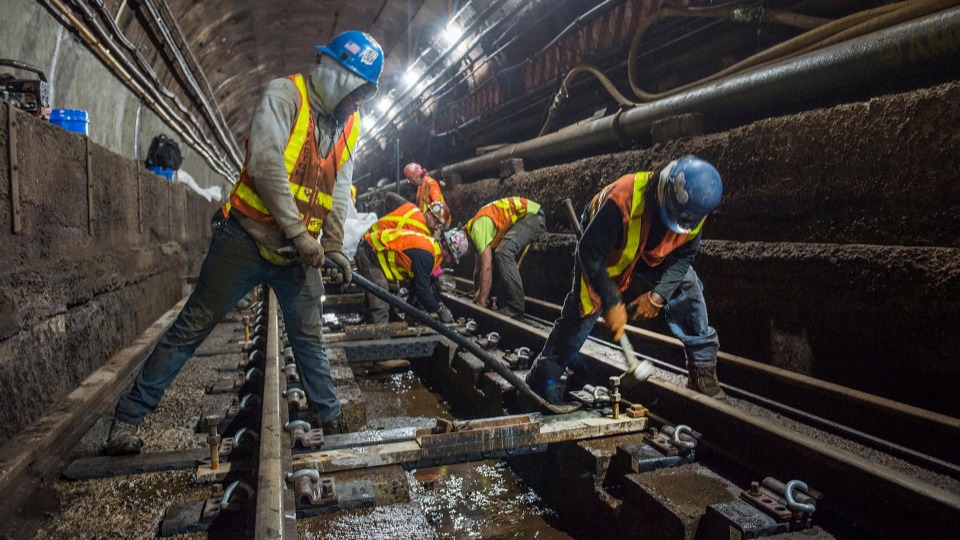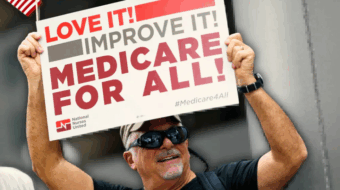
Early last summer, when it was already obvious that the pandemic was making a wreck of the economy, Joe Biden appeared to have a light bulb moment. He seemed to realize that everything had changed, and that, to keep up with history, he better change as well. “The blinders have been taken off,” Biden said in May. “Because of this COVID crisis, I think people are realizing, ‘My Lord. Look at what is possible. Look at the institutional changes we can make.”’
Progressives and unions have been urging the new president not to let the current crisis go to waste by squandering the opportunity to enact transformational economic and social reform. He’s taking their advice: With as much as $4 trillion of new spending to be unveiled over the coming weeks, it’s clear that the Biden administration is abundantly aware of what’s possible—and necessary.
The FDR-scale infusion of public investment being proposed by Biden will be split into two packages. The first is a gargantuan infrastructure bill aimed at rebuilding the nation’s crumbling roads, bridges, highways, railroads, utilities, and airports; expanding broadband access to the whole country; upgrading pipes to ensure clean drinking water and prevent another Flint-style crisis; boosting green energy to battle climate change; bumping up federal research and development budgets to revive manufacturing; improving veterans’ care; and more.

Full details are not yet available for the second half of the effort, but it will deal with “human infrastructure”: reducing the cost of childcare, providing paid family and medical leave, and extending current child tax credits through 2025. It may also include two years’ free community college, universal pre-K, and some level of relief for the student debt burden weighing down millions of young workers.
The massive $1.9 trillion American Rescue Act that passed earlier this month may ultimately end up being just the down payment on what Biden touts as his “Build Back Better” agenda. But stimulus checks, small business wage subsidies, COBRA health insurance help, and family assistance of the ARA were all put on the national credit card, financed through deficit spending.
This time is different. How does Biden propose to pay for the next round of spending? By making the rich and corporations foot the bill.
People’s needs vs. corporate greed
Wall Street seems to be of a split mindset over the plans. Analysts at Bank of America and other financial outfits are falling over themselves to quickly pinpoint which companies in sectors like broadband or computer chips might see a boost in business from the Biden investments. The stock pickers at Stifel analysts, who focus on construction and engineering companies, are advising clients on “ways to play the infrastructure spend.”
But fund managers and other market watchers are horrified by the tax hikes the administration plans to put on the table. Upon hearing of the scale of Biden’s possible tax increases, Dan Clifton, a stock brokerage advisor, told CNBC, “The market is just not ready for this. I’ve been totally bullish for a year, and now the flags are up.”
It’s expected that Biden will begin by rolling back at least a portion of the 2017 Trump tax cuts for the rich. A several-percentage-point increase in corporate income tax—possibly to 28% from the current 21%—is currently seen as the most likely outcome. Sen. Bernie Sanders is demanding that the Trump gift to big business be completely reversed, however, bringing back the old top rate of 35%.
Tech companies with extensive overseas operations may be on the hook for up to $800 billion in new taxes over ten years; Trump let them get away with reduced rates on profits earned and booked outside the country. And giant companies like Amazon, who’ve paid next to nothing in taxes for years, could be facing the prospect of a new minimum tax of at least 15% or so.
Hedge fund and private equity groups will probably be the hardest hit by new capital gains taxes. Previously, levies on capital gains were capped at just 20%. People who work for their paycheck at regular jobs, meanwhile, don’t enjoy any such benefit. Biden wants to close this loophole and tax stock market winnings just like ordinary income for couples earning more than $1 million annually. For working people with a 401k or smaller investments, though, they wouldn’t be subject to the capital gains tax hike.
Also targeted are huge estates, mega-wealth passed down generation to generation among the richest families. The Trump tax cuts shielded these big-money families, raising the estate tax exemption from $11 million to $22 million for couples. Biden says he wants Obama-era exemption of $3.5 million with a 45% rate to be revived.
The possible tax hikes Biden will pursue are, to employ a word so overused these days, unprecedented. But do you know who will pay no new taxes? People earning under $400,000 a year.
Strategic smarts to get both bills passed
As for getting the bills passed, it’s not going to be easy. So many pieces of progressive legislation have crashed lately on the shores GOP filibuster threats: the PRO Act workers’ rights bill, the George Floyd police reform bill, the pro-LGBTQ Equality Act, the “For the People” voting rights bill, and more. Are Biden’s infrastructure and tax plans doomed to the same fate?

Not necessarily. The White House is planning a strategy, together with the House and Senate Democratic leadership, that could get both halves of the Build Back Better plan through Congress.
The bulk of the physical infrastructure spending is all being put into the first bill. Job-creating programs like fixing bridges and roads or bringing high-speed internet to neglected rural areas are popular—even in Republican districts. At least a few GOP members of Congress are expected to back the bill, even if demanding amendments, possibly giving it a somewhat smoother path to becoming law.
The second half—the “human infrastructure” social spending part of the package—is expected to face unanimous Republican opposition. The GOP has no time for measures that provide direct help to families and the poor. Overcoming the 60-vote filibuster-proof threshold in the Senate would be impossible.
But that’s where the tax hikes come in. They will be held back in the first bill and all piled into the second one. Because the latter proposed legislation will then deal with taxation and budgets, the Democratic Senate leadership will be able to use the reconciliation rules that they employed to pass the American Rescue Act—meaning only 51 votes will be needed to make it law.
It’s strategically smart, and it could pull the rug from under Mitch McConnell and Republican obstructionists in the Senate.

Democrats vs. Democrats
The main hurdle standing in the way will likely be Democratic centrists, like Sen. Joe Manchin, who’s already complaining about whether the costs of the Biden plan will increase deficits. Others, such as Reps. Josh Gottheimer and Tom Suozzi, are demanding state and local income tax deductions for the wealthy as the price to get their support.
Labor unions and progressive activists are teaming up, though, to give Biden a confidence boost in the fight that will have to be had with the centrists. In a March 28 letter, a coalition that includes the labor-environmentalist BlueGreen Alliance, the Service Employees International Union, the Sunrise Movement, the International Brotherhood of Electrical Workers, the Working Families Party, the Center for American Progress, and others urged Biden:
“Seize this critical window of opportunity to…rebuild the economy, reverse growing inequality, confront systemic racism, reduce pollution, guarantee labor rights, and make necessary down payments in tackling the climate crisis.”
Targeting the centrists as well as the GOP, the labor-progressive statement was blunt: “Those who argue for small-minded measures are on the wrong side of history.”
During the Democratic primary—when unemployment was at 3.6% and no one had ever heard of COVID-19—Biden endeavored to convince wealthy campaign donors that “nothing would fundamentally change” if he won the presidency. What a difference a crisis—and the class struggle—can make.
Now, how about that $15 minimum wage?
As with all op-eds published by People’s World, this article reflects the opinions of its author.










